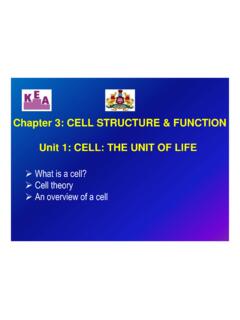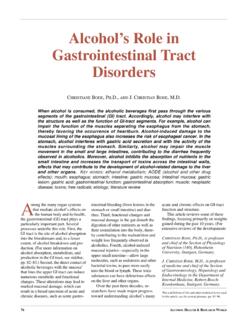Transcription of Chapter 12: The Cell Cycle
1 Copyright 2011 Pearson Education, Inc. - 1 - Name_____Period_____ Chapter 12: The Cell Cycle Overview: 1. What are the three key roles of cell division? State each role, and give an example. Key Role Example Reproduction An amoeba, a single-celled eukaryote, divides into two cells . Each new cell will be an individual organism. Growth and development A sand dollar embryo forms two cells shortly after the fertilized egg is divided. Tissue removal Dividing bone marrow cells will give rise to new blood cells . 2. What is meant by the cell Cycle ? The cell Cycle is the life of a cell from the time it is first formed from a dividing parent cell until its own division into two daughter cells . Concept Most cell division results in genetically identical daughter cells 3. What is the meaning of genome?
2 A genome is a cell s endowment of DNA, its genetic information. 4. How many chromosomes are in a human somatic cell? 46 5. Name two types of somatic cells in your body. Possible examples include any cells in the body, except for reproductive cells . 6. What is a gamete? A reproductive cell 7. Name the two types of gametes. Sperm and eggs 8. How many chromosomes in a human gamete? 23 9. Define chromatin. The complex of DNA and proteins that makes up eukaryotic chromosomes. When the cell is not dividing, chromatin exists in its dispersed form, as a mass of very long, thin fibers that are not visible with a light microscope. Copyright 2011 Pearson Education, Inc. - 2 - 10. Think carefully, now. How many DNA molecules are in each of your somatic cells ? 46 11. You are going to have to learn the difference between several similar-sounding terms.
3 The sketch below that looks like an X represents a replicated chromosome that has two sister chromatids. The narrow waist represents the location of the centromere. Students often get all these terms confused, so take time now to label the indicated areas of the figure and then define each of the terms below. See page 229 of your text for the labeled figure. chromosome: A cellular structure carrying genetic material, found in the nucleus of eukaryotic cells . Each chromosome consists of one very long DNA molecule and associated proteins. (A bacterial chromosome usually consists of a single circular DNA molecule and associated proteins. It is found in the nucleoid region, which is not membrane bounded.) See also chromatin. chromatid: One of two identical joined copies of the original chromosome centromere: In a duplicated chromosome, the region on each sister chromatid where they are most closely attached to each other by proteins that bind to specific DNA sequences; this close attachment causes a constriction in the condensed chromosome.
4 Chromatin: The complex of DNA and proteins that makes up eukaryotic chromosomes. When the cell is not dividing, chromatin exists in its dispersed form, as a mass of very long, thin fibers that are not visible with a light microscope. 12. Study Figure in your text. Label the figure below, and summarize what occurs at the DNA level in each stage. See page 230 of your text for the labeled figure. One of the multiple chromosomes in a eukaryotic cell is represented here, not yet duplicated. Normally it would be a long, thin chromatin fiber containing one DNA molecule and associated proteins; here its condensed form is shown for illustration purposes only. Once duplicated, a chromosome consists of two sister chromatids connected along their entire lengths by sister chromatid cohesion.
5 Each chromatid contains a copy of the DNA molecule. Molecular and mechanical processes separate the sister chromatids into two chromosomes and distribute them to two daughter cells . 13. What is mitosis? How is it different from cytokinesis? Mitosis, the division of the genetic material in the nucleus, is usually followed immediately by cytokinesis, the division of the cytoplasm. Copyright 2011 Pearson Education, Inc. - 3 - 14. What occurs in meiosis? How is the chromosome number of daughter cells different? The human body produces gametes eggs or sperm by a variation of cell division called meiosis, which yields nonidentical daughter cells that have only one set of chromosomes (23), half as many chromosomes as the parent cell.
6 15. Select either mitosis or meiosis to answer the following questions. Mitosis By what process are the damaged cells in a wound replaced? Meiosis By what process are eggs formed? Mitosis By what process does a zygote develop into a multicellular organism? Mitosis In which process are identical daughter cells produced? Meiosis Which process reduces chromosome number of daughter cells ? 16. Don t skip the Concept Check Questions! They are a good way to verify your understanding. Here is a variation of question 3. Answer it here: A hedgehog has 90 chromosomes in its somatic cells . a. How many chromosomes did the hedgehog inherit from each parent 45 b. How many chromosomes are in each of the hedgehog s gametes? 45 c. How many chromosomes will be in each somatic cell of the hedgehog s offspring 90 Concept The mitotic phase alternates with interphase in the cell Cycle 17.
7 Label each of the parts of the cell Cycle listed below, and give a brief explanation of what happens in each phase. See page 231 of your text for the labeled figure. G1: First Gap The first part of interphase S: Synthesis When the chromosomes duplicate G2: Second Gap The last part of interphase M: In the M phase, mitosis distributes the daughter chromosomes to daughter nuclei, and cytokinesis divides the cytoplasm, producing two daughter cells . 18. What are the components of the mitotic spindle? What is the source of these components? This structure consists of fibers made of microtubules and associated proteins. While the mitotic spindle assembles, the other microtubules of the cytoskeleton partially disassemble, providing the Copyright 2011 Pearson Education, Inc.
8 - 4 - material used to construct the spindle. The spindle microtubules elongate (polymerize) by incorporating more subunits of the protein tubulin and shorten (depolymerize) by losing subunits. The source of these components is the cytoplasm during prophase. 19. In animal cells , the assembly of spindle microtubules starts at the centrosome. What is another name for the centrosome? Microtubule-organizing center 20. Sketch and label a centrosome with two centrioles. See page 232 in your text to view the G2 of Interphase portion of the figure. 21. What are the components of the mitotic spindle? This structure consists of fibers made of microtubules and associated proteins. While the mitotic spindle assembles, the other microtubules of the cytoskeleton partially disassemble, providing the material used to construct the spindle.
9 22. Describe what happens to the centrosome during interphase and then prophase. During interphase, a cell that is about to divide grows and copies its chromosomes in preparation for cell division. During prophase, the centrosomes move away from each other, propelled partly by the lengthening microtubules around them. 23. What is a kinetochore? Read your text carefully, and then make a labeled sketch that shows a replicated chromosome with two kinetochores and some attached spindle fibers. Figure in your text may help. See page 236 of your text for the labeled figure. A structure of proteins attached to the centromere that links each sister chromatid to the mitotic spindle 24. You will need to spend some serious time with Figure in your text.
10 Use it to help you label this figure. Label each phase by name; then label the smaller structures. Finally, make two or three summary statements that indicate important features to note about the phase. Phase Important Features of Phase G2 of interphase Answers may vary; refer to the chart in Figure on pages 232-233. Prophase Answers may vary; refer to the chart in Figure on pages 232-233. Prometaphase Answers may vary; refer to the chart in Figure on pages 232-233. Copyright 2011 Pearson Education, Inc. - 5 - Metaphase Answers may vary; refer to the chart in Figure on pages 232-233. Anaphase Answers may vary; refer to the chart in Figure on pages 232-233. Telophase and cytokinesis Answers may vary; refer to the chart in Figure on pages 232-233.






